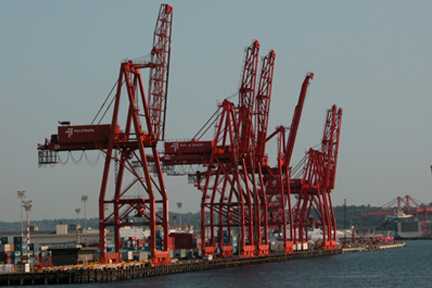Center for Maritime Safety and Health Studies

The Port of Seattle. Photo: Thinkstock
Marine Terminals and Port Operations
Marine terminals are the points of transfer for cargo loading and unloading as it is transferred from ships to rail and trucks. Marine terminals also facilitate the hiring of longshoremen to load and unload vessels at the port. Loading and unloading ships requires use of a variety of loading equipment, knowledge of techniques for lifting and stowing cargo, and the proper handling of hazardous materials. There are more than 3,700 marine terminals and 1,400 inter-modal connections in the United States. More than 45 million TEU’s (twenty-foot equivalent units) were moved through U.S. ports in 2006, and 99% of the volume of overseas trade enters or leaves the U.S. by ship1.
Longshoring work involves strenuous, physical labor. The hazards of the work include subjection to extreme temperatures, heavy lifting, repetitive motions, chemical exposures, and working around dangerous machinery. In addition, longshoremen work moving containers and other heavy loads with the potential to cause serious injury or death if a mistake is made.
Workers at marine terminals have higher fatality, injury and illness rates than other workers in the United States. There are approximately 98,000 marine terminal and longshoring workers2 employed at U.S. ports. Fatal injuries occur at a rate of 17.2 per 100,000 amongst these workers.3 There are also 5,200 nonfatal injuries/illnesses per year on average4.
References
- MARAD [2017] Marine Transportation System (MTS). Washington DC: US Department of Transportation, Maritime Administration, https://www.marad.dot.gov/ports/marine-transportation-system-mts/
- BLS [2016] NAICS 4883 Support activities for water transportation, US total, all ownerships, 2006 – 2016. In Quarterly Census of Employment and Wages. Washington DC: Bureau of Labor Statistics, https://www.bls.gov/cew/
- BLS [2016] NAICS 4883 Support activities for water transportation, all US, all ownerships, 2011 – 2014. In Census of Fatal Occupational Injuries. Washington DC: Bureau of Labor Statistics, https://data.bls.gov/cew/apps/data_views/data_views.htm#tab=Tables
- BLS [2016] Table 2. Numbers of nonfatal injuries and illnesses by industry and case types, 2011-2014. In : Survey of Occupational Injuries and Illnesses. Washington DC: Bureau of Labor Statistics, https://www.bls.gov/iif/oshsum.htm
- Page last reviewed: July 6, 2017
- Page last updated: July 18, 2017
- Content source:
Error processing SSI file


 ShareCompartir
ShareCompartir